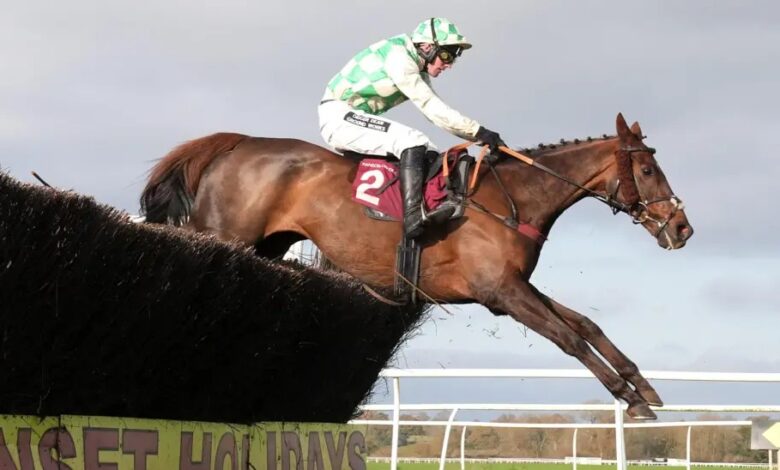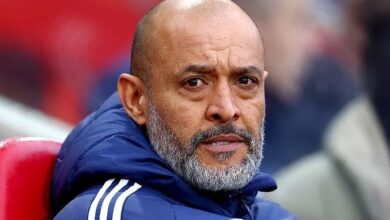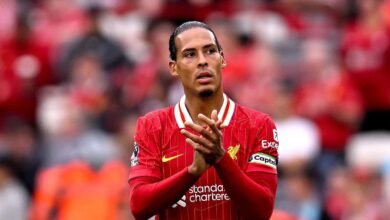Grand National horse that collapsed after final fence dies

Grand National runner Celebre d’Allen has died following Saturday’s race at Aintree.
The 13-year-old horse, the oldest of the 34 runners, was pulled up after the final fence and collapsed on the track.
Following treatment on the course, the gelding was walked into the horse ambulance and taken to the racecourse stables for further assessment.
But after initially showing signs of recovery, his condition “deteriorated significantly” and he died on Tuesday.
Jockey Micheal Nolan, Celebre d’Allen’s rider, was handed a 10-day suspension on Saturday after Aintree stewards ruled he had “continued in the race when the horse appeared to have no more to give and was clearly losing ground after the second-last fence”.
BBC Sport has been told Nolan will not face any further punishment from the British Horseracing Authority (BHA).
“To place blame entirely on the jockey is speculative and subjective in terms of being able to prove that,” said BHA chief executive Brant Dunshea.
Celebre d’Allen was a 125-1 shot at the National, which was won by jockey Patrick Mullins on Nick Rockett.
On Tuesday, it was also announced that Mullins has been given an eight-day ban after his ride was referred to the Whip Review Committee.
The amateur jockey, 35, breached the whip rules during the race, using his whip eight times after the final fence when the limit in jump racing is seven.
He will be suspended for eight separate days including 23 and 25 April.
What happened to the horse and was he fit to race?
The BHA said it would analyse the “race and incident in detail” and send the horse for a post-mortem investigation.
The horse had remained at Aintree on Saturday night before he was taken to a nearby stud farm connected to trainers Philip Hobbs and Johnson White Racing on Sunday “having shown improvement”.
In a statement, the trainers said: “He received the very best treatment by the veterinary teams and was improving. However, he deteriorated significantly last night and could not be saved. He was a wonderful horse and we will all miss him greatly.”
The BHA said Celebre d’Allen passed the necessary checks to race at Aintree.
“As with all runners in the Grand National, Celebre d’Allen was provided with a thorough check by vets at the racecourse,” a BHA statement read.
“This health check includes a trot up, physical examination of limbs to check for any heat, pain or swelling, and listening to the heart to check for any murmur or rhythm disturbance.
“This marks the final step in an extensive process of checks to ensure a horse’s suitability to race in the National, which also includes a review of veterinary records and assessment by a panel of experts to consider a horse’s race record and suitability to race.”
Animal welfare charity the RSPCA posted on X: “We await the British Horseracing Authority’s investigation into these deaths.”
What will happen to the jockey?
The BHA said the suspension given to Nolan was in line with the sport’s penalty framework and it would not be revisited.
The steward’s report said they interviewed Nolan and veterinary officer, and recordings of the incident were viewed before the ban was decided upon.
Nolan has received a significant volume of abuse since the incident and it now appears he has deleted his social media.
“It’s important to note that it’s also not possible to attribute the outcome of this incident to the jockey,” said Dunshea.
“As with humans a collapse and sometimes death can occur in fit and healthy horses of all breeds.”
He added: “Yes the horse should have been pulled up. The stewards took a dim view of that which is reflected in the penalty applied.
“Nobody can say for certainty the jockey’s actions have directly led to the outcome.”
How common is a fatality?
Celebre d’Allen was the second fatality at the Grand National festival after the Willie Mullins-trained Willy De Houelle sustained a fatal injury when falling in Thursday’s Juvenile Hurdle.
Broadway Boy, who led the National before suffering a heavy fall, has now returned home.
The BHA said that prior to Saturday’s race there had been no fatal injuries in the previous nine races run over the Grand National course since the 2023 event.
The number of runners in the showpiece race was cut from 40 to 34 after the 2023 race, where one horse died, to improve safety.
At 13, Celebre d’Allen was by far the oldest runner this year, but the BHA said that while there is not a set age limit, it is one of the factors considered by the Grand National Review Panel when determining whether a horse is suitable to race.
The BHA said there had been 24 13-year-olds since 2000 who have competed in the Grand National, with no fatalities.
The body cites exercise-associated sudden death, where a horse collapses and dies during or immediately after exercise, happens at an overall rate of 0.04% of runners.
Although it is not yet clear why the horse died, the BHA stressed what happened to Celebre d’Allen is “even rarer”.
What has been the reaction?
Celebre d’Allen’s death prompted criticism from animal rights groups.
“The blame for his death lies not with any individual, but with the ‘sport’ of horse racing itself,” said Animal Rising spokesperson Ben Newman.
“Again and again, we see horses pushed far beyond their limits, to the point of injury, collapse and death.”
Animal Aid campaigns manager Nina Copleston-Hawkens said: “To allow a horse of this age to be ridden to death in the most gruelling race in the country is disgraceful – and the blame for his end lies fairly and squarely with the British Horseracing Authority.”
World Horse Welfare chief executive Roly Owers said: “We are deeply saddened to hear about the death of Celebre d’Allen after last Saturday’s Grand National and our heart goes out to all those who cared for him. Every effort must be made to learn lessons from this very sad outcome.”
‘He pulled up as soon as he felt something’
Cheltenham Gold Cup-winning jockey Andrew Thornton, who was a BBC Radio 5 Live pundit for Saturday’s race, said he felt Nolan did “everything in his power to look after horse” and said his 10-day ban is a “severe penalty”.
“You can lose sight of the fact the horse jumped to the front of the race jumping three fences out, he was enjoying the race, running an absolute belter,” he said.
“There were three fallers and not one of them was Celebre d’Allen.
“From the jockey’s perspective he pulled up after the last fence as he felt something went amiss. The horse didn’t collapse immediately. He unsaddled him and was immediately concerned about the horse’s welfare.
“You can not see what’s going on inside the horse, as soon as he felt it, he has pulled it up. The BHA felt he should have pulled up earlier, in hindsight, it’s easy to say, would that have made a difference? Categorically no. What happened had already happened. If the horse was so bad it would not jumped the last fence. This was a split-second decision.
“Nolan is a stable jockey, riding for trainers who have over 3,000 winners, he knows horses inside and out. If something were amiss he would have pulled him up earlier. He is one of the kindest men you could come across, wanted to be in and around horses all his life.”
He added: “It is a fairly major ban, he is self-employed. He will lose rides he would have got and not necessarily get them back.”






